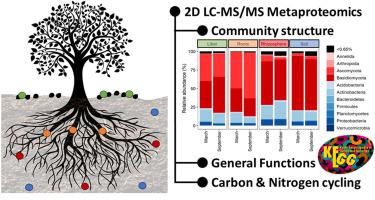Soil Biology and Biochemistry ( IF 9.8 ) Pub Date : 2021-02-09 , DOI: 10.1016/j.soilbio.2021.108170 Robert Starke , Rubén López Mondéjar , Zander Rainer Human , Diana Navrátilová , Martina Štursová , Tomáš Větrovský , Heather M. Olson , Daniel J. Orton , Stephen J. Callister , Mary S. Lipton , Adina Howe , Lee Ann McCue , Christa Pennacchio , Igor Grigoriev , Petr Baldrian

|
Temperate coniferous forests sustain the highest levels of biomass of all terrestrial ecosystems and belong to the major carbon sinks on Earth. However, the community composition and its functional diversity depending on the habitat have yet to be unveiled. Here, we analyzed the proteomes from litter, plant roots, rhizosphere, and bulk soil in a temperate coniferous forest at two time points to improve the understanding of the interplay between bacterial and eukaryotic communities in different habitats. Our metaproteomic approach yielded a total of 139,127 proteins that allowed to differentiate the contribution of microbial taxa to protein expression as well as the general functionality based on KEGG Orthology in each habitat. The pool of expressed carbohydrate-active enzymes (CAZymes) was dominated by fungal proteins. While CAZymes in roots and litter targeted mostly the structural biopolymers of plant origin such as lignin and cellulose, the majority of CAZymes in bulk and rhizosphere soil targeted oligosaccharides, starch, and glycogen. Proteins involved in nitrogen cycling were mainly of bacterial origin. Most nitrogen cycling proteins in litter and roots participated in ammonium assimilation while those performing nitrification were the most abundant in bulk and rhizosphere soil. Together, our results indicated niche differentiation of the microbial involvement in carbon and nitrogen cycling in a temperate coniferous forest topsoil.
中文翻译:

温带针叶林不同生境碳氮循环中细菌和真菌的生态位分化:一种元蛋白质组学方法
温带针叶林维持所有陆地生态系统中最高水平的生物量,属于地球上主要的碳汇。但是,取决于栖息地的社区组成及其功能多样性尚未揭晓。在这里,我们在两个时间点分析了温带针叶林凋落物,植物根,根际和块状土壤中的蛋白质组,以增进对不同生境中细菌和真核生物群落之间相互作用的了解。我们的元蛋白质组学方法产生了总共139,127种蛋白质,这些蛋白质可以区分微生物分类群对蛋白质表达的贡献以及基于每个生境的KEGG Orthology的一般功能。表达的碳水化合物活性酶(CAZymes)库由真菌蛋白控制。根和垫料中的CAZymes主要针对植物来源的结构生物聚合物,例如木质素和纤维素,而散装和根际土壤中的大多数CAZymes则针对寡糖,淀粉和糖原。参与氮循环的蛋白质主要来自细菌。凋落物和根中大部分的氮循环蛋白参与氨同化,而进行硝化的蛋白在块状和根际土壤中含量最高。总之,我们的结果表明在温带针叶林表层土壤中微生物参与碳和氮循环的生态位分化。参与氮循环的蛋白质主要来自细菌。凋落物和根中大部分的氮循环蛋白参与氨同化,而进行硝化的蛋白在块状和根际土壤中含量最高。总之,我们的结果表明在温带针叶林表层土壤中微生物参与碳和氮循环的生态位分化。参与氮循环的蛋白质主要来自细菌。凋落物和根中大部分的氮循环蛋白参与氨同化,而进行硝化的蛋白在块状和根际土壤中含量最高。总之,我们的结果表明在温带针叶林表层土壤中微生物参与碳和氮循环的生态位分化。











































 京公网安备 11010802027423号
京公网安备 11010802027423号